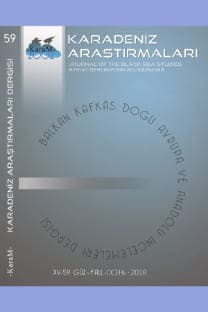ROLE AND POSITION OF TURKEY IN THE BLACK SEA REGION DURING THE PERIOD FROM 1946 TO 2012
___
- BLOYCE, D., & LOVETT, E. (2012). Planning for the London 2012 Olympic and Paralympic legacy: A figurational analysis. International journal of sport policy and politics, 4(3), 361-377.
- BONDONIO, P., & MELA, A. (2009). Which legacies of Torino 2006 OWGs for the Olympic movement and the local society?. In The Olympic Legacy People, Place, Enterprise Proceedings of the First Annual Conference on Olympic Legacy 8-9 May 2008 (pp. 31-44).
- BOUKAS, N., ZIAKAS, V., & BOUSTRAS, G. (2013). Olympic legacy and cultur- al tourism: exploring the facets of Athens' Olympic heritage. Interna- tional Journal of Heritage Studies, 19(2), 203-228.
- CANDREA, A. N., & ISPAS, A. (2010). Promoting tourist destinations through sport events. The case of Braşov. Revista de turism-studii si cercetari in turism, (10), 61-67.
- CASHMAN, R. (1998, October). Olympic legacy in an Olympic city: monu- ments, museums and memory. In Fourth International Symposium for Olympic Research; Global and Cultural Critique: Problematizing the Olympic Games (pp. 107-114).
- CASHMAN, R. (2003). Impact of the Games on Olympic host cities. Barcelona: Centre d'Estudis Olympics.
- GIRGINOV, V. (2011). Governance of London 2012 Olympic Games legacy. International review for the sociology of sport, 1012690211413966.
- GOLD, J. R., & GOLD, M. M. (2009). Riding the Mexican wave? Deciphering the meaning of Olympic legacy. In The Olympic Legacy People, Place, En- terprise Proceedings of the First Annual Conference on Olympic Legacy 8-9 May 2008 (pp. 9-20).
- GUALA, A., & TURCO, D. M. (2007, September). An analysis of Turin's Olym- pic legacy. In European Association for Sport Management Congress, Tu- rin, Italy.
- GUALA, C. (2009). To bid or not to bid: public opinion before and after the Games. The case of the Turin 2006 Olympic Winter Games. In The Olympic Legacy People, Place, Enterprise Proceedings of the First Annual Conference on Olympic Legacy 8-9 May 2008 (pp. 21-30).
- HERGUNER, B. (2012). The IOC as a transnational organization: Paradigm shift and its rising role in global governance. International Area Studies Review, 15(2), 176-186.
- KARACA, S. (2012). Türkiye'deki Büyük Ölçekli Spor Organizasyonlarının Kentin Kültürel Gelişimine Etkileri: Trabzon ve Erzurum Örnekleri. [The Impacts of Major Sports Events in Turkey on Cities' Cultural De- velopment: The Case of Trabzon and Erzurum] , ODA, 4, 42-47.
- KITCHENHAM, B., & PFLEEGER, S. L. (2002). Principles of survey research: part 5: populations and samples. ACM SIGSOFT Software Engineering Notes, 27(5), 17-20.
- MARSHALL, M. N. (1996). Sampling for qualitative research. Family practice, 13(6), 522-526.
- RITCHIE, J. B. (2000). Turning 16 days into 16 years through Olympic lega- cies.Event Management, 6(3), 155-165.
- SCHUTT, R.K. (2004). Investigating the Social World: The Process and Prac- tice of Research (4th ed.), Thousand Oaks: Sage Publication.
- TASHAKKORI, A., & TEDDLIE, C. (2003). Handbook of mixed methods in so- cial & behavioral research. Thousand Oaks, CA: Sage.
- VEAL, A. J., TOOHEY, K., & FRAWLEY, S. (2012). The sport participation leg- acy of the Sydney 2000 Olympic Games and other international sport- ing events hosted in Australia. Journal of policy research in tourism, lei- sure and events, 4(2), 155-184.
- ISSN: 2536-5126
- Yayın Aralığı: 4
- Başlangıç: 2004
- Yayıncı: Osman Karatay
Bir Yönetişim Konusu Olarak Büyük Spor Organizasyonlarının Mirası: Trabzon’dan Bir Vaka Calışması
GÜRCÜ DİLİ ÇALIŞMALARI VE GÜRCİSTAN'IN DİL POLİTİKASI
Odin and the As People in the Light of Turkic Culture and History
İKİ SAVAŞ ARASI DÖNEM POLONYA EDEBİYATINDA PSİKOLOJİK ROMAN
ROLE AND POSITION OF TURKEY IN THE BLACK SEA REGION DURING THE PERIOD FROM 1946 TO 2012
